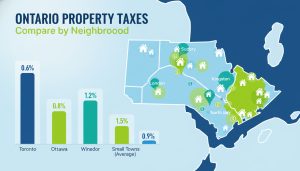How do property taxes vary across Ontario?
Shocking truth: Why your property taxes in Ontario could be twice your neighbor’s — here’s how
Quick answer: How property taxes vary across Ontario
Property taxes in Ontario change because municipalities set local tax rates, the province sets education levies, and assessed property values differ. Two identical homes can pay very different taxes if they’re in different towns, under different assessments, or subject to local levies.
How property tax is calculated (simple, actionable)
- Assessed value: MPAC provides a current assessed value for every property.
- Municipal tax rate: Your city or town sets the municipal rate to fund services.
- Education tax: Set provincially and added to your bill.
- Formula: Annual tax = Assessed value × (Municipal rate + Education rate). Rates are often shown as a percentage or mills per $1,000.
Do this now: find your assessed value at MPAC, then find your municipal tax rate on your town’s website. Multiply to get your expected bill.

Why two houses close by can pay very different taxes
- Assessment differences: Higher assessed values in hot markets push bills up even if the rate is lower.
- Rate differences: Small towns often need higher rates to cover fixed costs.
- Special levies: Waste, transit, infrastructure and stormwater charges change totals.
- Business mix and budget decisions: Municipalities with large commercial tax bases can keep residential rates lower.
Real-world example (illustrative): A $800,000 assessed home in a large city with a 0.8% combined rate pays about $6,400 a year. A similar home in a smaller town with a 1.5% rate pays $12,000. Same home value, different town — very different bill.
Data-driven signals to watch
- Effective tax rate = Annual taxes ÷ Market value. Use it to compare municipalities.
- Tax trend: Check municipal budgets and council minutes — sudden increases signal rate hikes.
- Assessment appeal rates: High appeal volumes can mean over-assessment risk in your area.
How to lower or control your property tax bill (action steps)
- Verify MPAC assessment: Request a review if the value looks wrong.
- Compare effective tax rates between neighbouring municipalities before you buy.
- Check for local relief programs: seniors’ credits, deferrals, or PIL reductions for non-profits.
- Budget for special levies in older municipalities (stormwater, bridge repair).
- Ask your realtor for a property tax comparison report — fast clarity before purchase.
Bottom line — practical takeaway
Property tax differences are driven by assessed value, municipal decisions, and provincial education levies. Don’t guess. Calculate. Compare effective tax rates. Appeal errors.
Need a personalized property tax comparison for your neighbourhood or an offer assessment before you buy? Tony Sousa is a local real estate expert who runs these numbers for buyers and sellers every day. Email tony@sousasells.ca or call 416-477-2620 for a fast, accurate tax breakdown and neighbourhood comparison.
Author: Local Realtor — neighborhood tax analysis and buying strategy help available at https://www.sousasells.ca





















